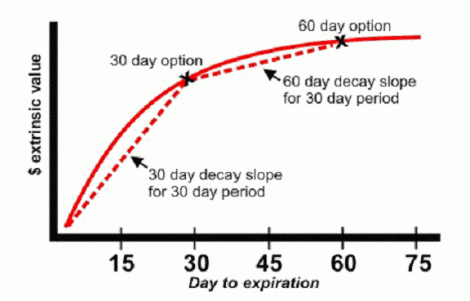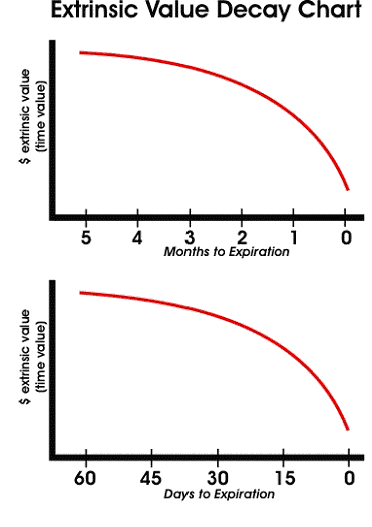
Time & Diagonal Spreads For Stocks Options TradingProvided By Options University You Must Understand These Spreads & How They Affect Stocks Options TradingBehavior of the Spread In Stocks Options Trading
Time spreads can be a profitable investment strategy for stocks
options trading if you understand the concept of time decay.
A time spread is designed to take advantage of the fact that a stocks options trading decay curve is non-linear; that is, a stocks options trading value does not decay evenly over time. As an option gets closer to expiration, its rate of decay increases meaning the option loses value more quickly. That decay rate increases progressively day after day until expiration.
Stocks options trading decay rate begins to accelerate when the option is about 45 days out. It picks up steam at 30 days out and really comes under decay pressure at about 15 days out. This scenario can be likened to a boulder rolling down from the top of a hill. As it starts, it rolls slowly and then gains more and more speed and momentum the further it gets down the hill until it achieves its maximum speed at the bottom. Option decay acts the same way- gathering speed and momentum as the option approaches expiration. In time spreads, both options have the same strike price that remains constant. However, each stocks options trading value decays at different rates and over different lengths of time. The option with one month until expiration experiences value decay at a faster rate than the value of an option that has three months until expiration. If you buy an option with three months to go and sell an option with the same strike but with one month to go you have set up a spread between the two stocks options trading value (prices). As time passes, your short option loses value for stocks options trading faster than your long option that decays more slowly. The value of the spread widens and you profit from that spreads expansion. This is the fundamental behavior of the time-spread.  The above chart shows stocks options trading decay graph. The numbers across the bottom represent days to expiration. Along the decay line, you will notice an X at the 30 day to expiration line and another X at the 60 day to expiration line. The first X represents a 30 day option while the second X represents a 60 day option. If you look closely at this chart you will see the nature of the stocks options trading time spread. Lets say you are long the 60-30 day stocks options trading time spread. That means you are long the 60 day option and short the 30 day option. Further, we will assign a price of $3.00 to the 60 day option and $2.00 to the 30 day option. Since you pay for the one and receive payment for the other the bottom line cost of what you put out for the stocks options trading spread is $1.00. Now, look at the slope of the line (representing decay) drawn from the 60 day stocks options trading to the 30 day stocks options trading. Compare the slope of that line to the slope of the line drawn from the 30 day stocks options trading to expiration (Day 0). As you can see, there is a big difference in the steepness of the slope of the two lines. The slope of the line drawn between the 30 day stocks options trading to expiration is much steeper than the slope of the line drawn from the 60 day stocks options trading to the 30 day stocks options trading. These slopes show how the time spread works! During the first 30 day period of time, the 30 day stocks options trading has a steeper slope, meaning a higher rate of decay. During that 30 day period, this stocks options trading will go from $2.00 to $0. Meanwhile, the 60 day stocks options trading, having a flatter slope will not decay as quickly. During the same 30 day period, it goes from $3.00 to $2.00. Remember, the stocks options trading spreads bottom line cost was $1.00. The 30 day option (now expired) will be worth $0 while the 60 day option (now 30 day option) will be worth $2.00. If you had invested in this stocks options trading spread, after 30 days decay you would be holding one option worth $2.00. The investment has provided a nice return! However, this is an ideal situation. The stocks options trading price and volatility remain constant and you capture the decay. The stocks options trading time spread has worked just as it should and it does work that way sometimes. But, nothing works as it should all the time. As we know, stocks options trading prices and volatility levels do not remain constant. They are always changing. In the time spread strategy the investor must choose opportunities carefully. In addition to picking a stock that will be in a stagnant period, the investor should look for two other where the spread has profit possibilities: changes in volatility and to a lesser degree stocks options trading price movements. Discover these secret option trading strategies that will have your friends calling YOU 'the options expert' Click here!
copyright 2005 Stocks Options Trading
|
